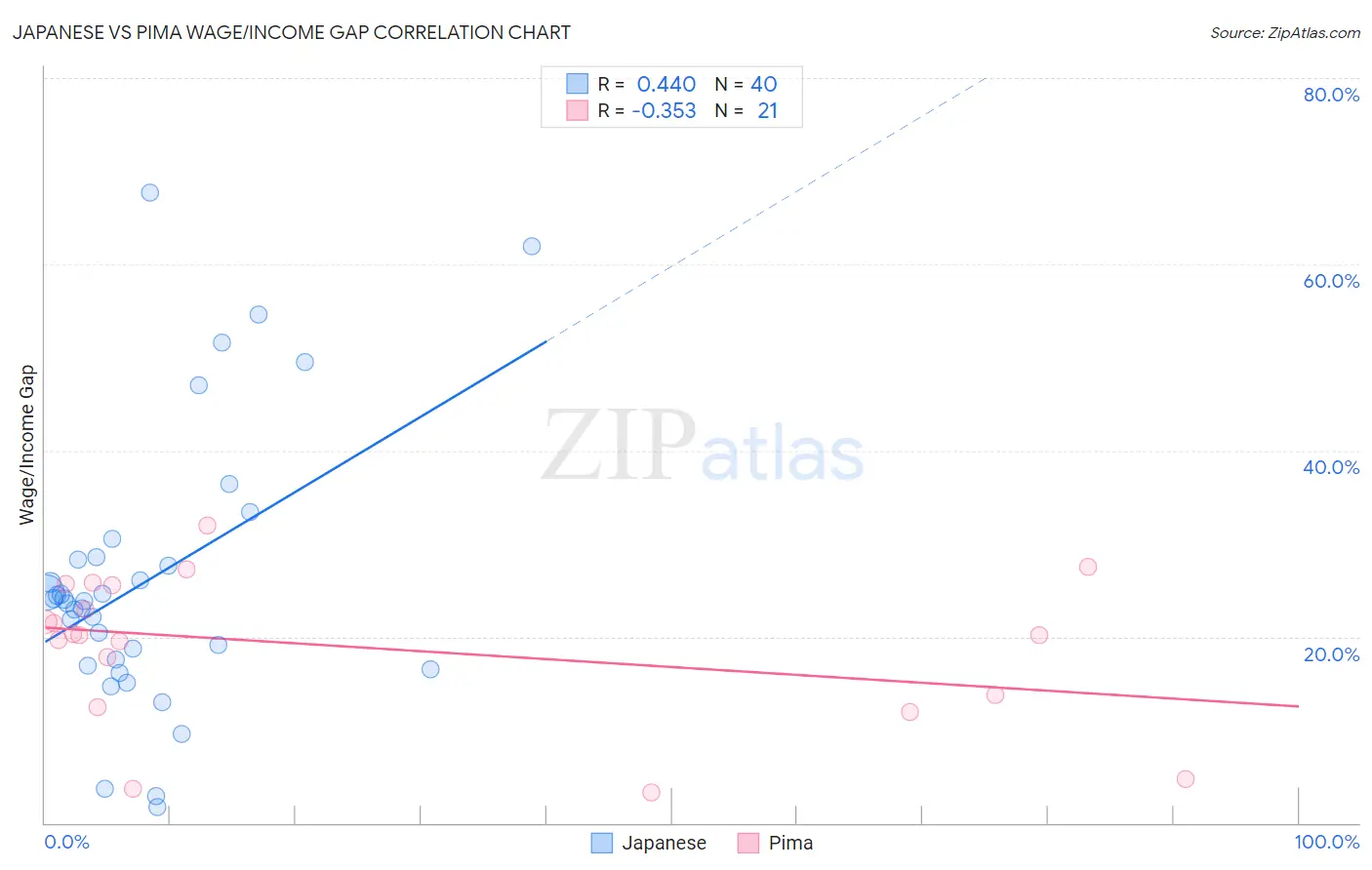Japanese vs Pima Wage/Income Gap
COMPARE
Japanese
Pima
Wage/Income Gap
Wage/Income Gap Comparison
Japanese
Pima
23.8%
WAGE/INCOME GAP
99.1/ 100
METRIC RATING
101st/ 347
METRIC RANK
21.1%
WAGE/INCOME GAP
100.0/ 100
METRIC RATING
34th/ 347
METRIC RANK
Japanese vs Pima Wage/Income Gap Correlation Chart
The statistical analysis conducted on geographies consisting of 249,130,971 people shows a moderate positive correlation between the proportion of Japanese and wage/income gap percentage in the United States with a correlation coefficient (R) of 0.440 and weighted average of 23.8%. Similarly, the statistical analysis conducted on geographies consisting of 61,509,383 people shows a mild negative correlation between the proportion of Pima and wage/income gap percentage in the United States with a correlation coefficient (R) of -0.353 and weighted average of 21.1%, a difference of 12.7%.

Wage/Income Gap Correlation Summary
| Measurement | Japanese | Pima |
| Minimum | 1.7% | 3.3% |
| Maximum | 67.8% | 31.9% |
| Range | 66.0% | 28.6% |
| Mean | 26.0% | 18.9% |
| Median | 23.9% | 20.2% |
| Interquartile 25% (IQ1) | 17.2% | 13.1% |
| Interquartile 75% (IQ3) | 28.4% | 25.6% |
| Interquartile Range (IQR) | 11.2% | 12.5% |
| Standard Deviation (Sample) | 14.8% | 8.0% |
| Standard Deviation (Population) | 14.6% | 7.8% |
Similar Demographics by Wage/Income Gap
Demographics Similar to Japanese by Wage/Income Gap
In terms of wage/income gap, the demographic groups most similar to Japanese are Immigrants from Laos (23.8%, a difference of 0.14%), Yakama (23.7%, a difference of 0.15%), Aleut (23.7%, a difference of 0.17%), Immigrants from Latin America (23.7%, a difference of 0.25%), and Tsimshian (23.9%, a difference of 0.37%).
| Demographics | Rating | Rank | Wage/Income Gap |
| Hondurans | 99.5 /100 | #94 | Exceptional 23.6% |
| Cape Verdeans | 99.4 /100 | #95 | Exceptional 23.6% |
| Kiowa | 99.4 /100 | #96 | Exceptional 23.6% |
| Immigrants | Sudan | 99.4 /100 | #97 | Exceptional 23.6% |
| Immigrants | Latin America | 99.2 /100 | #98 | Exceptional 23.7% |
| Aleuts | 99.2 /100 | #99 | Exceptional 23.7% |
| Yakama | 99.2 /100 | #100 | Exceptional 23.7% |
| Japanese | 99.1 /100 | #101 | Exceptional 23.8% |
| Immigrants | Laos | 99.0 /100 | #102 | Exceptional 23.8% |
| Tsimshian | 98.9 /100 | #103 | Exceptional 23.9% |
| Tlingit-Haida | 98.7 /100 | #104 | Exceptional 24.0% |
| Moroccans | 98.6 /100 | #105 | Exceptional 24.0% |
| Sudanese | 98.6 /100 | #106 | Exceptional 24.0% |
| Yaqui | 98.4 /100 | #107 | Exceptional 24.0% |
| Immigrants | Albania | 98.4 /100 | #108 | Exceptional 24.0% |
Demographics Similar to Pima by Wage/Income Gap
In terms of wage/income gap, the demographic groups most similar to Pima are Immigrants from Bahamas (21.1%, a difference of 0.28%), Immigrants from Yemen (21.1%, a difference of 0.30%), Vietnamese (21.0%, a difference of 0.53%), Somali (21.2%, a difference of 0.55%), and Belizean (21.2%, a difference of 0.57%).
| Demographics | Rating | Rank | Wage/Income Gap |
| Immigrants | Armenia | 100.0 /100 | #27 | Exceptional 20.7% |
| Inupiat | 100.0 /100 | #28 | Exceptional 20.8% |
| Immigrants | Senegal | 100.0 /100 | #29 | Exceptional 20.9% |
| Immigrants | Bangladesh | 100.0 /100 | #30 | Exceptional 20.9% |
| Vietnamese | 100.0 /100 | #31 | Exceptional 21.0% |
| Immigrants | Yemen | 100.0 /100 | #32 | Exceptional 21.1% |
| Immigrants | Bahamas | 100.0 /100 | #33 | Exceptional 21.1% |
| Pima | 100.0 /100 | #34 | Exceptional 21.1% |
| Somalis | 100.0 /100 | #35 | Exceptional 21.2% |
| Belizeans | 100.0 /100 | #36 | Exceptional 21.2% |
| Immigrants | Somalia | 100.0 /100 | #37 | Exceptional 21.2% |
| Immigrants | Belize | 100.0 /100 | #38 | Exceptional 21.3% |
| Colville | 100.0 /100 | #39 | Exceptional 21.3% |
| Lumbee | 100.0 /100 | #40 | Exceptional 21.3% |
| Liberians | 100.0 /100 | #41 | Exceptional 21.4% |